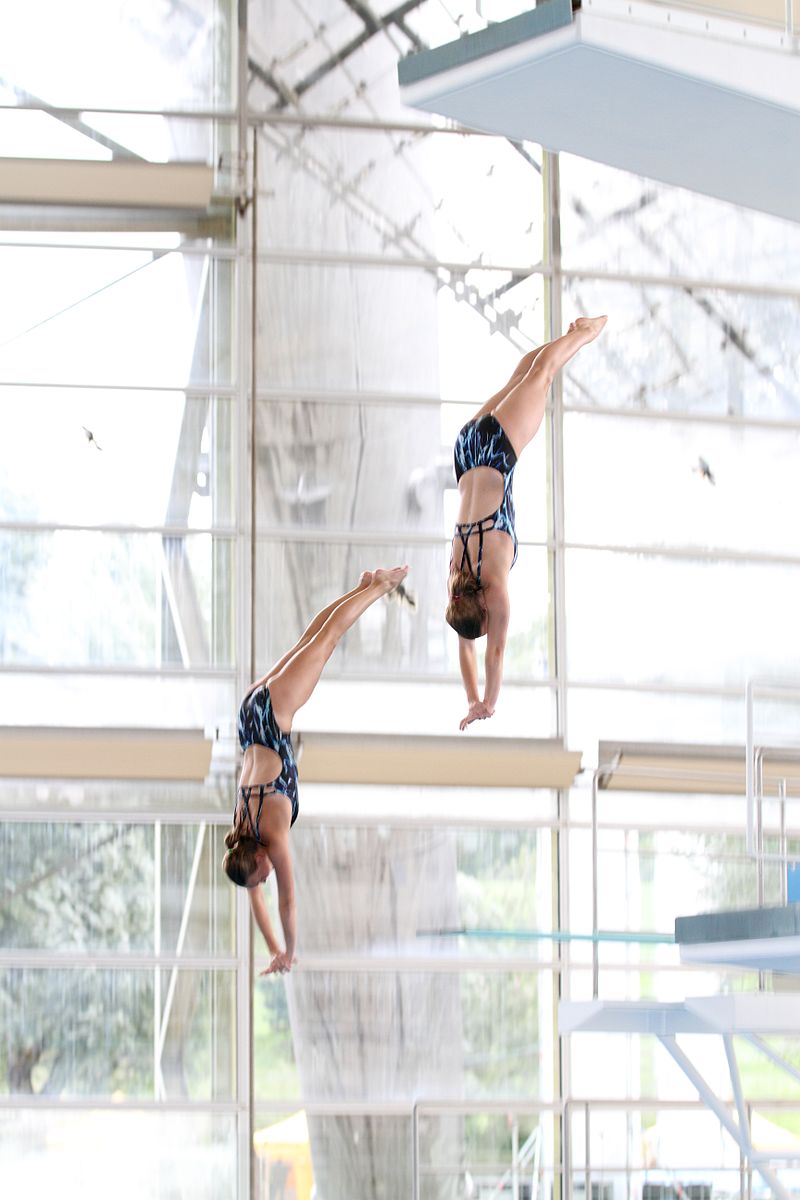High diving is the act of diving into water from relatively great heights. High diving can be performed as an adventure sport (as with cliff diving), as a performance stunt (as with many records attempts), or competitively during sporting events. It debuted as a sport at the 2013 World Aquatics Championships in Barcelona. In the world championships, men jump from a 27-metre-high (89 ft) platform while women jump from a 20-metre-high (66 ft) platform. In other official competitions, men generally dive from a height of 22–27 metres (72–89 ft) while women dive from a height of 18–23 metres (59–75 ft). The sport is unique in that athletes are often unable to practice in an authentic environment until the days leading up to a competition. High diving has been designated a sport separate from regular diving by FINA. High divers have achieved speeds of descent of 96 kilometres per hour (60 mph).
High Diving
History
Initially, diving as a sport began by jumping from “great heights”. Then it was exclusively practiced by gymnasts as they found it exciting with a low probability of injury. It then evolved into “diving in the air” with water as the safety landing base. Efforts by Thomas Ralph to name the sport “springing” were not realized, as the term “diving” was by then firmly rooted. It soon became a sporting event pursued by many enthusiasts. In the early years of the sport, finding suitable places to jump was an issue, and people started jumping from any high place – in Europe and the United States they started jumping from bridges, then diving head first into the water. This evolved into “fancy diving” in Europe, and, particularly in Germany and Sweden, as a gymnastic act. The sport further improved with gymnastic acts being performed during the diving process, and was then given the names “springboard diving” and “high fancy diving”, which were events in the Olympics of 1908 and 1912. The first diving event as a sport, however, was in 1889 in Scotland with a diving height of 6 feet (1.8 m). Today, in Latin America, diving by professionals from heights of 100 feet (30 m) or more is a common occurrence.
Cliff diving has been documented as far back as 1770 when Kahekili II, king of Maui, engaged in a practice called “lele kawa,” which in English means jumping feet first into water from great heights without making a splash. The king’s warriors were forced to participate to prove that they were courageous and loyal to the king. The practice later developed into a competition under king Kamehameha I, and divers were judged on their style and amount of splash upon entering the water.
On 14 January 1933, Dutchman Lou Vlasblom made a well documented dive from the top of one of the towers of the Rotterdam Koningshaven bridge from a height of 65 meters.
The first female world champion in this sport was Cesilie Carlton of the United States, who won the first gold medal at the 2013 World Aquatics Championships with a total score of 211.60. The first male world champion was Orlando Duque of Colombia who received a score of 590.20.

Rules
The rule of diving a relatively straightforward, but differ slightly between the two main disciplines, springboard diving, and platform diving.
Springboard Diving
- Six dives should be completed by men, five by women
- Dives can be performed at any difficulty level
- One dive during the contest must come from each of five different categories (forward, back, reverse, inward, twisting)
- Men may repeat one of the categories for their sixth dive, women may not
- Each dive must be different, meaning no dive can be repeated
Platform diving & Synchronized Springboard
- Men complete six dives, women complete five
- For both men and women, the first two dives must have a difficulty level of 2.0
- The remaining dives for both men and women can be of any difficulty level
- Both men and women must complete dives from at least four different categories with at least one of the dives being forward facing
Equipments
1. A High-Quality Diving Mask
Unfortunately, our eyes were not made to work perfectly underwater. Instead, to see perfectly without the problem of blurred vision or painful eyes, a diving mask is essential. This should be one of your top equipment priorities. After all, there is no point going diving if you can’t even see your incredible surroundings clearly.
Having a high-quality diving mask can make all the difference to your diving expedition. While renting diving masks is a possibility, buying a new one that perfectly fits and meets your needs is definitely best.
2. A Reliable Wetsuit
When it comes to diving and maintaining a comfortable temperature under the water for long periods of time, you’re going to want a dependable wetsuit. Typically made from neoprene rubber, wetsuits are effective at locking a thin layer of water alongside your skin, which acts as padding and maintains a comfortable body temperature while you explore under the water.
3. Fins to Get You Through the Water
The experience of diving is so much more enjoyable when you can move effortlessly through the water. Scuba fins help facilitate ease of movement and help you move through the water with more speed and agility than you would otherwise have managed. This is vital for an exciting and enjoyable diving trip as it helps you to explore and slowly reduce energy, rather than tiring yourself out.
Efficiency and comfort are vital when it comes to choosing a pair of high-quality fins. So, make sure you do your research before splashing your cash.
4. Depth Gauge, Submersible Pressure Gauge, & Compass
Some of the most essential pieces of dive equipment are a depth gauge, submersible pressure gauge, and a compass. The depth gauge records how deep you are travelling on your dive, the submersible pressure gauge displays the amount of gas remaining in your scuba tank, helping you monitor your supply, and a compass helps you know where you are – even when there’s low visibility.
When purchasing this equipment, you can choose either analogue or digital forms, it depends on your preferences. Alternatively, you can purchase a 3-gauge instrument which combines all three pieces in one device – ideal if you’re prone to losing or forgetting things!
5. Tank Bangers for Communication
Maybe you’ve heard of these or maybe you haven’t, but tank bangers are an essential piece of dive gear. These hard materials on elastic bands are usually wrapped around a diver’s cylinder and can be used by snapping the hard material against your tank to get another divers attention. This is ideal if you need to warn someone of a dangerous predator or some other emergency and could very well save your life.
6. Diving Cylinder
If you’re a diver, it goes without saying that diving cylinders are nothing short of essential for any diving expedition. Diving cylinders are your main source of oxygen and provide you with vital oxygen while you’re exploring the depths. Depending on your experience and the length of your dive, among other things, the size of your cylinder may vary. So, ensure you carry out the appropriate research to choose the appropriate cylinder for your dive requirements.
7. Quality Diving Footwear
‘Diving footwear’ may seem like a strange term, but this covers a range of quality accessories that keep your feet safe and comfortable at all times. After all, there are so many jagged rocks, coral, and other hard surfaces in reefs and on the ocean floor that you can’t simply jump in wearing any old footwear. So, do your research and ensure you find some quality diving footwear to protect your feet throughout your dive.
Associations
- WORLD HIGH DIVING FEDERATION.
- World Recreational Scuba Training Council.






